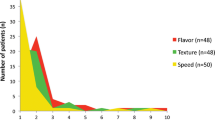Abstract
Objective. To evaluate the safety and efficacy of orally administered perflubron for bowel recognition on MR imaging in a pediatric population.Materials and methods. A multicenter trial evaluated 39 pediatric subjects before and after ingestion of perflubron with T1−, proton-density, and T2-weighted sequences through the abdomen and/or pelvis. Post-contrast images were compared with pre-contrast images. Safety was evaluated through assessment of adverse events, clinical laboratory parameters, and vital signs.Results. With regard to efficacy analysis, improvement in the percent of bowel darkened was observed for 85 % of the subjects on T1-weighted images and for 95% of the subjects on proton-density and T2-weighted images. For images of the abdominal region, the percent of bowel darkened was improved for 90–92 % of the subjects across pulse sequences. Improvement rates for the images of the pelvic region ranged from 71 % to 100 %. For at least 75 % of the subjects, proton-density and T2-weighted images of the body and tail of the pancreas, left lobe of the liver, mesenteric fat, and pathological tissue were improved relative to predosing images. Twenty-three percent of the subjects experienced some adverse effects, most of which were minor and related to the digestive system. Clinical laboratory and vital sign evaluations revealed no trends associated with the administration of perflubron.Conclusion. Perflubron is a relatively safe and effective gastrointestinal MR contrast agent in the pediatric population.
Similar content being viewed by others
References
Bisset GS (1989) Evaluation of potential practical oral contrast agents for pediatric magnetic resonance imaging. Preliminary observations. Pediatr Radiol 20: 61–66
Brown JJ, Duncan JR, Heiken JP, et al (1991) Perfluoroctylbromide as a gastrointestinal contrast agent for MR imaging: use with and without glucagon. Radiology 181: 455–460
Patten RM, Lo SK, Phillips JJ, et al (1993) Positive bowel contrast agent for MR imaging of the abdomen: phase-11 and -111 clinical trials. Radiology 189: 277–283
Tart RP, Li KC, Storm BL, Rolfes RJ, Ang PG (1991) Enteric MRI contrast agents: comparative study of five potential agents in humans. Magn Reson Imaging 9: 559–568
Laniado M, Kornmesser W, Hamm B, Clauss W, Weinmann HJ, Felix R (1988) MR imaging of the gastrointestinal tract: value of Gd-DTPA. AJR 150: 817–821
Mattrey RF, Hajek PC, Gylys-Morin VM, et al (1987) Perfluorochemicals as gastrointestinal contrast agents for MR imaging: preliminary studies in rats and humans. AJR 148:1259–1263
Bach Gansmo T, Dupas B, Gayet Delacroix M, Lambrechts M (1993) Abdominal MRI using a negative contrast agent. Br J Radiol 66: 420–425
Mattrey RF, Trambert MA, Brown JJ, et al (1994) Perflubron as an oral contrast agent for MR imaging: results of a phase-III clinical trial. Radiology 191: 841–848
Listinsky JJ, Bryant RG (1988) Gastrointestinal contrast agents: a diamagnetic approach. Magn Reson Med 8: 285–292
Van Beers B, Grandin C, Jamart J, Demeure R, Jacobsen TF, Pringot J (1992) Magnetic resonance imaging of lower abdominal and pelvic lesions: assessment of oral magnetic particles as an intestinal contrast agent. Eur J Radiol 14: 252–257
Rubin DL, Muller HH, Nino Murcia M, Sidhu M, Christy V, Young SW (1991) Intraluminal contrast enhancement and MR visualization of the bowel wall: efficacy of PFOB. JMRI 1: 371–380
Kaminsky S, Laniado M, Gogoll M, et al (1991) Gadopentetate dimeglumine as a bowel contrast agent: safety and efficacy. Radiology 178: 503–508
Hahn PF, Stark DD, Lewis JM, et al (1990) First clinical trial of a new superparamagnetic iron oxide for use as an oral gastrointestinal contrast agent in MR imaging. Radiology 175: 695–700
Lonnemark M, Hemmingsson J, Carlsten J, Ericsson A, Holtz E, Klaveness J (1988) Superparamagnetic particles as an MRI contrast agent for the gastrointestinal tract. Acta Radiol 19: 599–602
Li KC, Ang PG, Tart RP, Storm BL, Rolfes R, Ho Tai PC (1990) Paramagnetic oil emulsions as oral magnetic resonance imaging contrast agents. Magn Reson Imaging 8: 589–598
Nunnally R (1984) Improved MR imaging of the upper abdomen with glucagon and gas. J Comput Assist Tomogr 8:835–838
Pels Rijcken TH, Davis MA, Ros PR (1994) Intraluminal contrast agents for MR imaging of the abdomen and pelvis. J Magn Reson Imaging 4: 291–300
Li KCP, Tart RP, Fitzsimmons JR, Storm BL, Mao J, Rolfes RJ (1991) Barium sulfate suspension as a negative oral MRI contrast agent: in vitro and human optimization studies. Magn Reson Imaging 9: 141–150
Marti Bonmati L, Vilar U, Paniagua JC, Talens A (1991) High-density barium sulphate as an MRI oral contrast. Magn Reson Imaging 9: 259–261
Hahn PF, Stark DD, Saini S, Lewis JM, Wittenberg J, Ferrucci JT (1987) Ferrite particles for bowel contrast in MR imaging: design issues and feasibility studies. Radiology 164:37–41
Schumacher DJ, Steinbach G, Keane S, Buxton RB, Unger E, Mattrey RF (1991) Comparison of artifacts generated by oral MRI contrast agents in vitro. Invest Radiol 26 [Suppl]: 1125
Author information
Authors and Affiliations
Rights and permissions
About this article
Cite this article
Bisset, G.S., Emery, K.H., Meza, M.P. et al. Perflubron as a gastrointestinal MR imaging contrast agent in the pediatric population. Pediatr Radiol 26, 409–415 (1996). https://doi.org/10.1007/BF01387316
Received:
Accepted:
Issue Date:
DOI: https://doi.org/10.1007/BF01387316




